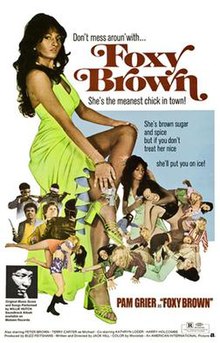While Foxy Brown doesn't quite match up with Coffy on some levels, the two films helped establish Pam Grier as an icon of '70s soul chic and would go on to inspire similar female-starring blaxploitation pictures like Sugar Hill (1974), TNT Jackson (1975), and Velvet Smooth (1976), amongst others.
Foxy Brown does outdo its predecessor in a couple areas, namely the opening credits sequence (done with psychedelic '70s colors and Pam Grier doing kung-fu dance moves) and the theme song and musical score by Willie Hutch (The Mack, 1973), which brings the soul-funk and keeps it there so it rattles in your eardrums. Lots of wah-wah, strings, and flutes. Fuck, I love flutes.
Foxy has two problems in her life: her brother and her boyfriend. Her ambitious brother Link (Antonio Fargas) is a no-good, habitual criminal and loser she has to constantly bail out of trouble. Her boyfriend Michael (Terry Carter) is another kind of trouble. He and Foxy care about each other very much, but he's an undercover government agent trying to bust a drug syndicate, which puts him in direct danger. After going through an operation to change his appearance (and name to Dalton), Foxy hides him at her apartment, but unfortunately his path crosses with Link's, who figures out who he is really, and sells him out to the syndicate. Michael/Dalton is shot down on Foxy's front porch, which commences the need for Foxy's revenge.
She finds that the murder is connected to a "modeling agency" ran by kinky weirdos Steve Elias (Peter Brown) and Miss Katherine (Kathryn Loder), so she decides to pose as a prostitute and infiltrate the agency. On her first job, she meets another prostitute named Claudia (Juanita Brown) who wants out of the business, and who is more than willing to help Foxy take Miss Katherine down. After the pair of them embarrass a client (an old judge who has at thing for black chicks) they hide out in a lesbian bar, but the lesbians take a liking to Claudia. This leads to a barroom lady-brawl which features face slaps, pulled hair, broken bottles, a smashed jukebox, and Foxy throwing chairs around, proclaiming she's got "a black belt in barstool." It's a cool scene, but it doesn't quite compare to the catfight in Coffy. (i.e. no tops are ripped off).
After escaping the lesbian bar, Foxy and Claudia are both captured by Katherine's goons, and Claudia is hauled away (we never see or hear about her again). Foxy is beaten, tortured, and sent to "the ranch," one of their drug labs. There she is bound to a bed, guarded by two hicks, forced to take heroin, abused, and raped. She manages to escape and exact her fiery revenge on her tormentors, before fleeing and contacting members of a street gang and enlisting their assistance in finishing the job she started.
It's in this section that we see the biggest differences between Coffy and Foxy Brown. Coffy was never a victim and she was fiercely independent, never calling on the help of any men to help her. These qualities helped lay the foundation for Coffy (and Pam Grier) as a symbol and role model of feminine empowerment. Conversely, Foxy is victimized, abused, and forced to take drugs. Even though she escapes on her own accord, and she is shown many times as a strong and empowered woman, she does enlist the help of a squad of men to help her finish her task. The presence of this street gang, while needed somewhat, seriously diminish the power that she holds as a solo vigilante.
Jack Hill regular Sid Haig has a fairly small part in this film (especially compared to Coffy), maybe less than 15 minutes screen time, as a pilot named Hays who works for the drug ring. After Foxy hooks up with the street gang, she sets her plan in motion by seducing Hays and convincing him to let her join him in Mexico while he makes a drug drop. She of course steals the plane and uses it to do some serious damage to some thugs, but none of it is as nasty as her ultimate revenge on Elias and Miss Katherine.
Pam Grier once again combines her likability and good looks with a kickass, no-nonsense attitude. The costume designers went the extra mile in this one, giving Pam some remarkable outfits that really helped define her as a pop culture icon. She retains her sexiness without ever being as naked as she was in Coffy, but don't worry, there's plenty of skin in the film.
Antonio Fargas is probably best known as Huggy Bear on televison's Starsky and Hutch. He's also featured in Shaft (1971), Across 110th Street (1972), Cleopatra Jones (1973), and Car Wash (1976). The same year as Foxy Brown, Terry Carter would also star in the blaxploitation/Exorcist rip-off Abby and the family classic Benji, but he's probably best known for his roles on popular '70s television shows like McCloud (Sgt. Broadhurst) and the original Battlestar Galactica (Col. Tigh).
Kathryn Loder also starred with Pam Grier and Sid Haig in Jack Hill's The Big Doll House (1971). Juanita Brown was busy in 1974, also starring in Willie Dynamite, Black Starlet, and Jonathan Demme's Caged Heat (her only film credits). Peter Brown would star in the mean and salacious Rape Squad (1974) and was also in Kitten with a Whip (1964), a film featured on the sixth season of Mystery Science Theater 3000.
Foxy Brown is a meaner and nastier film than Coffy, and maybe a little less coherent (the quick production probably has a lot to do with that), but it's still a fun exploitation film that is required viewing for fans of '70s cinema or blaxploitation films. That ain't no jive.


Excellent review. I just discovered these movies for myself. I mostly knew them through pop-culture osmosis.
ReplyDelete